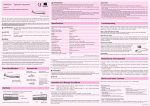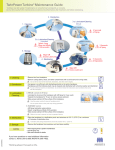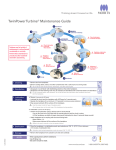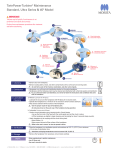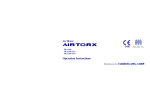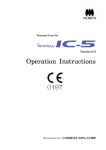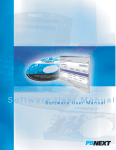Download Parts Identification Accessories Symbols Specifications
Transcript
TORQTECH Operation Instructions ST-DH Straight Handpiece Attachment 2011-08-22 PUB. H5074-E-1 Thank you for purchasing a TorqTech straight motor handpiece attachment. For optimum safety and performance, read this manual thoroughly before using the unit and pay close attention to the warnings and notes. Keep this manual in a handy place for ready reference. The following symbols and expressions indicate the degree of danger and harm that could result from ignoring the instructions they accompany: This warns the user of the possibility of extremely serious injury or complete destruction of the instrument as well as other property damage including the possibility of fire. This warns the user of the possibility of mild injury or damage to the instrument. This alerts the user of important points concerning operation or the risk of equipment damage. Disclaimer ■■ The J. Morita Mfg. Corp. will not be responsible for accidents, equipment damage, or bodily injury resulting from: 1. repairs made by personnel not authorized by the J. Morita Mfg. Corp. / 2. any changes, modifications, or alterations of its products / 3. the use of products or equipment made by other manufacturers, except for those procured by the J. Morita Mfg. Corp. / 4. maintenance or repairs using parts or components other than those specified by the J. Morita Mfg. Corp. and other than in their original condition / 5. operating the equipment in ways other than the operating procedures described in this manual or resulting from the safety precautions and warnings in this manual not being observed / 6. workplace conditions and environment or installation conditions which do not conform to those stated in this manual such as improper electrical power supply / 7. fires, earthquakes, floods, lightning, natural disasters, or acts of God ■■ The J. Morita Mfg. Corp. will supply replacement parts and be able to repair the product for a period of 10 years after the manufacture of the product has been discontinued. ■■ Warranty is honored only when a claim is accompanied by the warranty agreement with purchase date, product name and model, serial number (inscribed on the body of the product) and name of the distributor. ■■ Do not fail to thoroughly read the user manual for your motor and follow all the instructions and cautionary remarks in it. ■■ The owner (clinic, hospital or medical institution) is responsible for use and maintenance of medical devices. • After inserting a burr, always operate the handpiece outside of the oral cavity to make sure it runs smoothly. • If a burr comes out during use, stop using the attachment immediately and have the instrument repaired. • Never use a burr or point to pull up on a metal crown or other metal piece. This is very dangerous; the burr could come out and injure the patient or be swallowed. • Never use the instrument with no or too little cooling air; this could cause it to heat up and possibly burn the doctor's hand or the patient's mouth. • Always use a soft (feather), intermittent touch to avoid injury to the pulp. • Wait for the burr to stop rotating before taking it out of the oral cavity. • To avoid cutting your finger etc., wait until the instrument has completely stopped rotating before inserting or removing a burr or point. • Never turn the lock sheath while the instrument is actually running. This could cause the whole straight attachment to start rotating and create a dangerous situation. Specifications Troubleshooting Straight Attachment ST-DH Rotation Speed Ratio Maximum Motor Speed Length Weight Usable Burrs * Chuck Type Chuck Gripping Power Cooling Air Flow Spray Flow Tip Air Flow Connection Type Connectable Motors Usable Burr Length Usable Burr Diameter Maximum Burr Length 1:1 42,000 rpm 83 mm 73 g Shank Type 2 (HP) Mechanical Lock Conforms to ISO 7785-2 Minimum 6 NL / min. (from motor) 50 ml / min., minimum (for 0.2 MPa instrument pressure) 1.5 L / min., minimum (for 0.2 MPa instrument pressure) Conforms to ISO 3964 and DIN 13940 Conforms to ISO 13294 and ISO 11498 30 mm minimum Φ2.334 to Φ2.350 mm 44.5 mm * Use burrs that conform to ISO 1791-1 [Specifications may be changed without prior notice due to improvements.] Always use burrs and points with clean shanks; dirty shanks cause the chuck to wear out more quickly and lose its gripping power. Always carefully remove all cleaning fluids before inserting a burr into the chuck; some cleaning fluids are corrosive, and if a burr or point with cleaning fluid on it is inserted, the chuck could be ruined. ■■ This instrument must not be used by anyone except legally qualified dentists and oral surgeons / practitioners. Diamond points are easily bent. Even new burrs and points are sometimes poorly balanced: if a burr makes a loud, metallic noise during rotation, stop using it. This instrument equipment must be only used for its specified dental treatment purpose. If a dirty burr or one with cleaning fluid has been inserted by mistake, contact your local dealer or the J. Morita Office to have the instrument inspected. Caution: Federal law restricts this device to sale by or on the order of a dentist (for U.S.A.). Parts Identification • Never use the following types of burrs and points; they could come out and injure the patient or be swallowed: Those which do not conform to ISO standards. Those with scratched or bent heads or shanks. Those which are rusty, chipped or broken. Those which have been modified or altered such as those having shortened shanks. Accessories Spray Nozzle (Disinfect with ethanol) Spray Hole Wire (Disinfect by autoclave) • Wear safety glasses to prevent eye injury. • Never switch rotation direction from forward to reverse or vice versa while the motor is actually running. • Remove burrs and points before returning the instrument to its holder in the treatment unit; otherwise, there is a risk of injury or damage. • Crown removal and other similar operations produce considerable vibration and can cause the burr to get stuck in the handpiece. Avoid this by frequently taking the bur out and putting it back in again. If a burr gets stuck, do not try to take it out with a pair of pliers or other forceful means; this could damage the chuck and create a risk of a burr coming out during operation. Contact J. Morita and have the instrument repaired. • If the instrument makes abnormal noise, vibrates too much, or overheats, take out the burr and replace it with a new one. If the same problem persists, have the instrument repaired. • Follow all recommendations of the burr manufacturer concerning burr rotation speed and direction. • Use burrs and points with shanks that are at least 30 mm long. If the cutting tip touches the end of the attachment, it could get too hot and burn the patient, or the attachment could be damaged. Before inspecting or adjusting the instrument, make sure the main power switch is turned on and that the main air and water valves are open. If the instrument does not work properly even after inspection and adjustment, contact your local dealer or the J. Morita corp. and have it repaired. Burr or Point will not go in chuck. Make sure the burr or point is OK. Clean and lubricate the instrument with LS Spray (sold separately). If this does not solve the problem, have the instrument repaired. Burr does not rotate. Make sure motor is properly connected to its tube. Take the TorqTech attachment off the motor and step on the foot pedal to see if the motor runs. If the motor runs, put the attachment back on and see if the burr rotates. If it doesn't, have the TorqTech attachment repaired. If the motor doesn't run, refer to the user manual for the motor. Spray is not emitted. Take the TorqTech attachment off the motor and step on the foot pedal to see if water comes out of the motor joint. If water comes out, check the o-rings on the motor joint and replace them if they are worn out or damaged. Coat new o-rings with a little oil. If the o-rings are OK, clean the air and water holes on the TorqTech attachment. If there is still no spray, have the TorqTech attachment repaired. If water doesn't come out, refer to the user manual for the motor. Overheating Make sure flows for cooling air and spray are up to specifications. Also make sure the motor is operating properly. Maintenance and Inspection ■■ The user (hospital, medical institute or clinic) is responsible for inspection and maintenance of medical devices. ■■ The user (i.e., clinic, hospital etc.) must perform the inspection procedures specified in "Maintenance and Inspection" every three months. ■■ For parts that wear out and need periodic replacement, refer to the Inspection Items and replace parts whenever necessary. ■■ It is assumed that the user will perform regular maintenance and inspection procedures. However, if necessary or desired, these may be performed by a trained professional qualified to repair medical devices. Contact your local dealer or the J. Morita Office. Inspect the following items: 1. Motor connection. 2. Burr and point insertion. 3. TorqTech rotation and spray. 4. Overheating. • If a burr has a welded or soldered joint, do not use it if the head wobbles. Lock Sheath Identification Ring (Blue: 1:1 rotation ratio) * For parts that wear out and need periodic replacement, refer to the Inspection Items and replace parts whenever necessary. Operation and Storage Conditions Service and other Contacts ■■ For repairs or other types of service contact your local dealer or the J. Morita Office. Operation : Temp.: 10° C (50° F) to 40° C (104° F). Relative Humidity: 30 ~ 75 % (without condensation). Atmospheric Pressure: 700 ~ 1,060 hPa Storage : Temp.: -10 (14° F) to 70° C (158° F). Relative Humidity: 10 ~ 85 % (without condensation). Atmospheric pressure: 700 ~ 1,060 hPa Symbols May be cleaned and disinfected with a thermal washer-disinfector. Autoclavable up to 135° C. Model *Avoid frequent or prolonged exposure to direct sunlight. *If instrument will not be used for a long time, autoclave it and store it in a clean, dry place. *The working-life of TORQTECH attachments is 7 years from the date of shipment provided they are regularly and properly inspected and maintained. Gear Ratio Disposal of Medical Devices : Manufacturer Conforms to European medical device Directive 93 / 42 EEC. Type Serial Number Any medical devices which could possibly be contaminated must be first decontaminated by the responsible doctor or medical institution and then be disposed of by an agent licensed and qualified to handle medical and industrial waste. ‘11.08. 1,500 K Printed in Japan 1. Inspect and Autoclave Before Use 6. Disinfection The TORQTECH attachments are not autoclaved before shipping. Do not fail to autoclave the attachments before using them. Wipe the attachment with a piece of gauze that has been dampened with ethanol and wrung out thoroughly. Make sure the chuck opening is rust-free and clean. Make sure the motor joint is clean and not damaged. Connect the attachment to the motor and operate it. Make sure it rotates smoothly, emits a fine, misty spray, and there is no air or water leakage from the motor joint. Also make sure that there is no abnormal noise, excessive vibration, or overheating. Do not use anything except ethanol. Do not use too much ethanol; it could seep inside and damage the instrument. Rotation and spray delivery will be impaired if debris gets inside the water or air lines. Never wipe the instrument with corrosive solutions such as electrolytic acids, strong alkaline solutions, or other special cleaning solutions commonly available. • Do not use the attachment if it is bent, warped or otherwise deformed. 2. Motor Connection Thermal Washer Disinfector : Instruments with this symbol may be cleaned and disinfected with a thermal washer-disinfector. To use a thermal washer-disinfector, first read the operation instructions for the unit. Strictly follow the instructions attached for cleaning mode and solution. *Refer to the user manual for the motor. Improper cleaning modes and solutions will damage the instrument. Make sure the o-rings on the motor's connection cylinder are OK. Follow the disinfector manufacturer's recommendations for cleaning solutions and methods for dental instruments. Do not use strong acidic or alkaline solutions. Thoroughly rinse off all cleaning solution. Push the TorqTech attachment straight onto the motor's connection cylinder until you hear it snap into place. 7. Lubrication Make sure the motor's connection cylinder is free of dust, dirt, and debris. Do not connect this attachment to a motor that rotates faster than 40,000 rpm. 1. Do not drop the instrument or bang it against anything. This could cause it to malfunction. *Lubricate with LS Spray (sold separately) before autoclaving and after morning and afternoon treatment sessions. 2. 1. Remove the burr or point and take the TorqTech attachment off the motor. 2. Open the chuck. Open • Give the attachment a light tug before using it to make sure it is securely connected. • Wait for the motor to come to a complete stop before connecting or disconnecting the attachment. • Use a motor that conforms to ISO 13294/ ISO 11498; otherwise there is a risk of electrical leakage. 3. 4. firmly and then spray for about 2 seconds. The instrument will fail if it is not lubricated and cleaned with LS Spray regularly. Do not use LS spray for any instruments except those with ball bearings. Insert Do not use any lubricant except LS Spray. Other lubricants will cause the connection o-rings to swell and make it difficult to connect and disconnect. Absolutely never use AC Cleaner, which is for air bearings. If you do, the bearings will burn out as soon as the instrument is rotated. Remove The head could get quite cold if the spray is applied for more than 5 seconds. In this case, wait awhile before operating the handpiece; otherwise the bearings could be damaged. *2 Open chuck *1 Shake the LS spray can 2 or 3 times before use and always use it in an upright position. Use only the special spray nozzle provided. Insert burr all the way in. *2 OK NO Open the chuck all the way and pull the burr out. *1 Close chuck. Turn sheath until triangle marks (▲▼) line up. *1 • Always cover the attachment with gauze before spraying. If spray accidentally gets into your eyes, wash them out with plenty of water and see a doctor. Use soap and water to wash off any spray on your skin. • Do not use the LS Spray in an enclosed arrea which is not properly ventilated. Do not point the spray nozzle at anyone and do not use the spray near an open flame. 8. Remove Excess Spray Closed Open 1. 2. 1. Put an air nozzle (motor accessory) on the end of a threeway syringe. 2. Put the nozzle in the connection end of the TorqTech attachment and blow air through it for 20 or 30 seconds. Wipe off the oil that gets on the surface of the instrument with a piece of gauze. Never rotate the attachment with the chuck open. • Always insert burrs and points all the way in and give them a light tug to make sure they will not come out. Otherwise, a burr or point could come out and injure the patient or be swallowed. • Wait for the instrument to completely stop rotating before inserting or removing a burr or point. • Take care not to injure your fingers when inserting and removing burrs and points. 4. After Use 3. Put the nozzle on the LS Spray can. 4. Insert the nozzle into the connection end of the TorqTech attachment, hold it 3. Insert and Remove Burrs and Points Lock sheath (*The spray will not be effectively delivered if the chuck is closed.) • Do not fail to eliminate excess oil after lubricating the attachment; otherwise, oil might seep into the motor and damage it. Also excess oil could cause the attachment to overheat. 9. Packaging and Sterilization *Refer to the user manual for the motor. Take out the burr or point and disconnect the TorqTech attachment from the motor. *It may be hard to remove a burr or point if it is left in the attachment. Wipe the attachment with gauze, put it in a sterilization pouch, and autoclave it. Recommended Autoclaving Conditions: In a sterilization pouch, at least 6 minutes at 134° C (273.2° F) or at least 60 minutes at 121° C (249.8° F) *Autoclaving and drying temperatures must not exceed 135° C (275° F) *Minimum drying time after sterilization: 10 minutes. Do not sterilize in any way except autoclave. Do not fail to clean and lubricate the instrument before autoclaving it. After autoclaving, take the instrument out of the autoclave as soon as it cools off. 5. Cleaning High autoclave temperatures can damage the o-rings etc. Keep the handpiece from directly contacting heat sources or the inside of the autoclave by putting it into a sterilization pouch. Clean debris off the attachment with a brush and running water. • To prevent the spread of serious, life-threatening infections such as HIV and hepatitis B, the TorqTech attachments must be autoclaved after finishing the treatment of each patient. • Instruments are extremely hot after autoclaving; do not touch them until they cool off.


